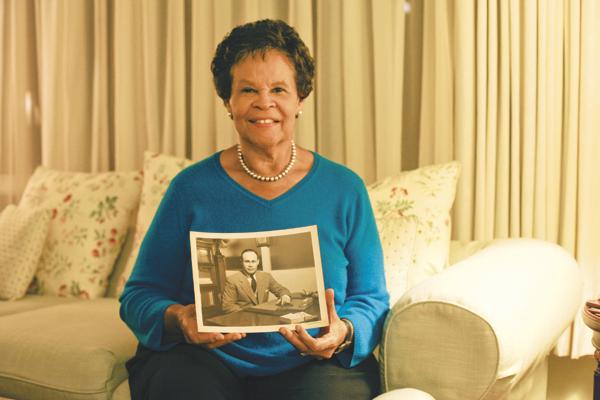Charlene Drew Jarvis’ family history is stitched into the Thaddeus Stevens School.
The historic elementary school, closed since 2008, sits idly between 21st and K streets with a faded white brick facade and playground enclosed behind a chain-link fence. It was the city’s first public school for black children, nurturing generations of Jarvis’ family since her grandmother attended more than 120 years ago.
The former 20-year D.C. Council member now supports a plan to breathe new life into the school by bringing a special education program inside its walls.
“Not only will it be a school, but it will be a school that will preserve the history,” said Jarvis, who wrote a letter to the city’s zoning board last year supporting the project. “I think those of us who do remember it have an obligation.”

D.C.-based real estate developers Akridge and Argos will present plans to the Council this spring on how to redevelop the building that will now be operated by the Rockville-based Ivymount School. A 10-story office complex will also be constructed next door.
The four-story school, built in 1868 to serve the neighborhood’s growing black population, has remained vacant for five years. It was one of 23 schools closed during education reforms by former D.C. Public Schools Chancellor Michelle Rhee.
Jarvis said her grandmother, who was born in 1880, went to Stevens before she graduated from Howard University in 1901. Jarvis’ father, renowned blood bank pioneer Dr. Charles Drew, was born three years later in his family’s home on 18th and E streets and graduated from Stevens in 1918.
Two decades later, Drew became the first African-American doctor to earn his degree from Columbia University, and later became the director of the American Red Cross blood bank.
“My father and his mother were the beneficiaries of some of the best teachers who had the highest expectations for the students,” Jarvis said, adding that many teachers at Stevens were highly trained but unable to get jobs in the segregated white schools in the District.
Jarvis and her cousin, Fred Gregory, said they both grew up hearing about the school from their parents. Gregory, a retired Air Force colonel who is also a GW alumnus, said his mother “continued to make loving comments about Stevens even when she was very ill.”
Gregory, who became the first African-American to command a space flight on the space shuttle Discovery in 1989, attributes their family’s success to the high standards that were set for their parents at Stevens.
“The school, community, home and church all had the same set of values, and if you strayed, everyone else knew about it,” Gregory said.
The fate of the 145-year-old school became unclear in 2009 as former D.C. mayor Adrian Fenty clashed with neighborhood leaders who were determined to preserve the historical site as a school building. Fenty sought to turn the space into an apartment complex, concerning neighbors who thought the units would be filled by rowdy GW students.
Gray ended years of debate in August 2012 when he chose developers for the $75 million project, a compromise supported by the neighborhood’s top advisory group that fall.
Foggy Bottom Council member Jack Evans, who opposed Fenty’s plan, said the historical significance of the school makes it “very important” for the neighborhood.
“There was strong support among the [Advisory Neighborhood Commission] and others in the neighborhood to have an education component of that project,” Evans said in an interview.
The construction timeline for the project is not yet clear, and David Toney, the vice president for development at Akridge, said the team is “still very early in the process,” working with the Office of the Deputy Mayor for Planning and Economic Development to create terms of use for the D.C.-owned land.
Council Chairman Phil Mendelson declined to comment on whether he would support the agreement until he sees the final legislation. Chanda Washington, a spokeswoman in the city’s planning office, said he will eventually introduce the legislation to the Council on behalf of the mayor, when it will then be up for a Council vote.
Molly Whalen, a spokeswoman for Ivymount, said leaders at the 52-year-old school plan to create a “lab school” at the Stevens location, where teachers in D.C. can be trained to work with students whose intellectual or developmental disabilities create challenges in mainstream schools.
“The goal would be that those students could go back to a less restrictive environment, hopefully in their home area,” Whalen said.
About 50 D.C. public school and charter school students, many with autism, are now enrolled in one of four special education programs at the 220-student Rockville location.
Whalen said the recent spike in students diagnosed with autism has made it tough for teachers to keep up with the necessary training. The Stevens school program would fit about 50 elementary-age students, who could come from neighborhoods all over the city.
The refurbished buildings will preserve parts of the school’s history: The office complex will feature a gallery wall with art made by black artists and Stevens school students, according to the city’s planning office’s website. The redevelopment also includes funds for college scholarships for Foggy Bottom students with special needs.
In an interview at her home near Silver Spring on Friday, Jarvis said the Stevens School has remained an important part of her family for over a century because of the way it helped connect them to their community.
“We felt that our family had a rich interest in a broad culture,” Jarvis said. “The Stevens School was simply a part of this rich culture that we shared in Washington because of the nature of our teachers and our support system.”







